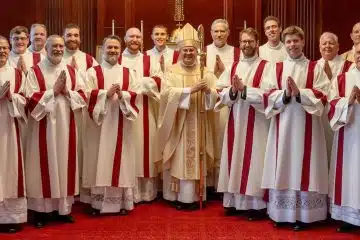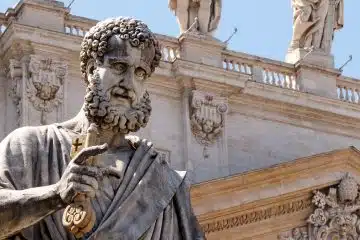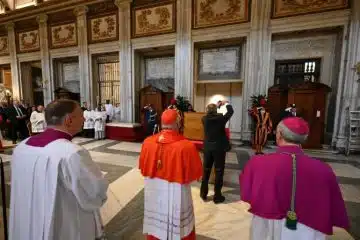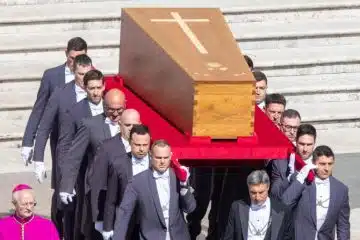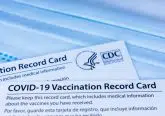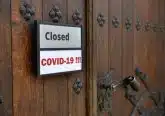Guidelines for the Resumption of Public Worship in the Archdiocese of Cincinnati
Effective immediately, and until further notice:
• The Catholic faithful who reside in the Archdiocese of Cincinnati and all other Catholics in the archdiocese continue to be dispensed from the obligation of attending Sunday Mass. Those who are at risk or fearful that they or their family might become sick are encouraged to stay home and join the Church by viewing live-streamed Masses.
• Public worship may begin in the Archdiocese of Cincinnati on Monday, May 25. Each parish should offer at least one public Mass daily. Pastors may determine whether it is necessary and prudent to celebrate more than one Mass on Saturday and Sunday. Here it should be remembered that the faithful have been dispensed from the obligation to attend Sunday Mass. Thus, those who wish to participate in Mass and receive Holy Communion can do so by attending any Mass any day of the week. For the benefit of the faithful, the live-streaming of liturgies should continue if at all possible. The health and safety of vulnerable priests should also be considered in this regard.
• In all circumstances, appropriate social distancing and the regulations put forth by public health authorities must be observed. Pastors are to creatively regulate the number of people in the church at one time, space people around the nave to ensure appropriate distancing, and — if possible — pre-register to gauge expected attendance. The faithful should be made aware of these measures.
Guidelines to be observed:
• The guidelines of safety and hygiene already in place will continue, including:
o Water should be removed from baptismal and holy water fonts.
o The gifts of bread and wine should be kept from public areas, brought directly from the credence table to the altar.
o No physical contact at the Our Father or Sign of Peace.
o Discreet use of hand sanitizer by ministers of Holy Communion.
o No Holy Communion from the chalice by the faithful; concelebrating priests should Communicate by intinction.
o Holy Communion on the tongue is strongly discouraged.
o Vessels should be cleansed after each Mass with hot, soapy water
• Additional guidelines for safety and hygiene include:
o Hymnals, missalettes, and other materials should be removed from the pews. Consider using a disposable worship aid or the use of familiar hymns, songs, antiphons, and acclamations.
o The faithful should be encouraged to wear a face mask; ministers of Holy Communion may wear a face mask; priest celebrant is discouraged from wearing a mask.
o With respect for the liturgical norms, the number and placement of ministers may be reduced:
§ A deacon may fulfill the roles of lector and server.
§ If servers are ministering, consider using adults.
§ Ministers may be seated further apart than normal.
§ Evaluate the necessity of Extraordinary Ministers of Holy Communion and the number needed for each Mass.
§ As permitted by the missal, presidential prayers may take place at the altar, or a podium may be setup at the chair, reducing the need for servers.
o Consideration should be given to reducing the role of choirs and ensembles in light of social distancing and public health regulations.
o Ensuring proper reverence, Mass should not be unnecessarily long; homilies should be brief.
o No collection baskets may be passed from hand to hand; consider a monitored collection point (i.e. an usher monitoring a single basket near the main doors of the church) to minimize contact.
o The bread to be consecrated for the Communion of the faithful should be placed on a corporal at the edge of the altar, not directly in front of the priest celebrant. Alternatively, the use of covered ciboria would likewise be appropriate.
• Other than as Viaticum to the critically ill, Holy Communion should, whenever possible, be given in the context of Mass. If however this is not possible, Holy Communion may be given outside of Mass, according to the approved rites. The distribution of Holy Communion immediately after Mass (rather than during) is to be avoided.
• The Elect may be baptized at any Mass, preferably on Sunday. Non-Catholic Christians may also be received into full communion at any Mass, or outside of
Mass following the approved rites. As always, pastors should seek faculties to confirm Catholic adults by writing to the Chancellor ([email protected]).
• First Communion may be celebrated at any time; consider smaller groups of candidates at multiple celebrations.
• If necessary to ensure social distancing and conform to public health regulations, Mass (including a nuptial or funeral Mass) may be celebrated outside of the parish church, but preferably on parish grounds. Specific permission must be sought in advance from the Vicar General ([email protected]).
Suggested Strategies to Consider for Implementation:
SOCIAL DISTANCING
• Remind the faithful that they have been dispensed from their Sunday obligation, and thus their desire to participate in Mass could be fulfilled on any day of the week.
• Determine the maximum capacity of your church based on the 6-feet rule, and plan for ways to regulate the number of people inside at any one time.
• Deliberately use every other or every third pew/row; mark off other pews/rows.
• Mark pews/rows with different colors and use only certain colored pews/rows at certain liturgies (e.g. red pews/rows at one Mass, blue pews/rows at the next Mass) to reduce the need for cleaning in between Masses.
• Reduce the number of possible entrances into the church to better regulate attendance and preserve one-way traffic patterns.
• Count the number of attendees at Mass to anticipate future crowds.
• Utilize auxiliary but connected spaces like choir lofts, transepts, etc. to maximize capacity.
• Consider designating one side of the church for families (entire pews would be set aside) and the other side of the church for Individuals or couples (observing social distancing, a single pew could likely accommodate more than one station).
• With perhaps the assistance of ushers, consider seating in the front pews first and then working to the back of the church.
• Invite people to RSVP in advance of coming to Mass using services such as SignupGenius, Eventbrite, etc.
• Consider the routes of the Communion procession to avoid two-way traffic.
• If long-handled collection baskets are not available, setup monitored collection points around the church for offering envelopes. Remind parishioners about opportunities for online giving.
• Suspend Children’s Liturgy of the Word unless this can be done with appropriate social distancing.
• Instruct hospitality ministers (if their presence is absolutely necessary) in ways of greeting the faithful with appropriate social distancing, if this can be done.
• Avoid ministers greeting the faithful after Mass unless this can be done with proper social distancing.
• Avoid social activities (e.g. coffee and donuts) unless this can be done with proper social distancing and food safety protocols.
• Ensure that the reception of disposable worship aids can be done safely and with appropriate social distancing; either place new ones in each pew before Mass, and/or make it available online for viewing on tablets or smartphones during Mass.
• Ensure that the giving of bulletins after Mass can be done safely and with appropriate social distancing; perhaps emphasize online access to bulletins and other important publications.
• If more space is needed for the Sacrament of Reconciliation, use a larger room rather than the usual confessional, and emphasize the use of a screen.
HEALTH SAFETY
• Make hand sanitizer available at each entrance.
• Clean all possible surfaces frequently, especially those touched frequently by multiple people, even between liturgies.
• Reduce the number of touchpoints as people enter by propping open doors or having one person open doors.
• Wipe down books, vessels, and other materials.
• Clean liturgical vestments regularly and avoid sharing albs among ministers.
• The use of the larger-sized congregational altar breads (i.e. 1 3/8″) will reduce the hand-to-hand contact between minister and Communicant.
• Use wood soap and water to clean pews, chairs and other wooden surfaces; test this on unseen surfaces to avoid damaging the finish.
• Clean restrooms frequently, even between Sunday liturgies.
• Ensure proper ventilation in public spaces.
• An instrument (e.g. cotton swab) may be used for the Sacrament of the Anointing of the Sick. (N.B. this is not possible for Chrismation; anointing with Oil of Catechumens is always optional)
Resources:
U.S. Centers for Disease Control and Prevention (CDC): Guidance for Faith-Based Organizations
Ohio Dept of Health Checklist for Faith-Based Organizations
With questions or concerns, please contact the Office for Divine Worship & Sacraments.


